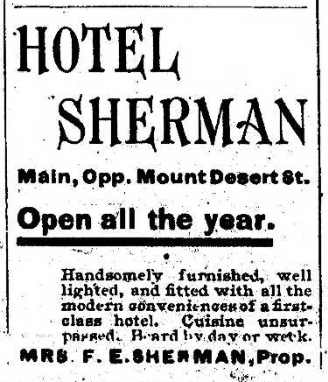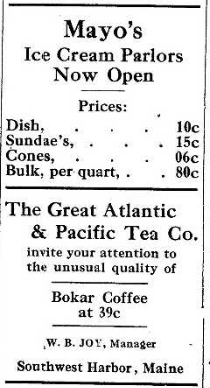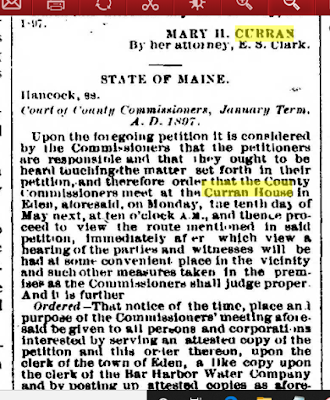CHANGES IN BAR HARBOR DURING A QUARTER OF A CENTURY 1879 - 1904
Bar Harbor Record
by George H. Grant
The rapid growth of Bar Harbor, Mt. Desert Island, for the last few years, calls in mind some of the early experiences, while in business there.
In the spring of 1879 I went from Rockport to Bar Harbor on the little steamer May field; a most beautiful sail but an all day trip. This boat and the steamer Lewiston, each making two trips per week, where the only means of reaching Bar Harbor except by stage drive from Bangor, a distance of about fifty miles.
My employment at that time being telegraph operator, my first office was a small room in the basement of the old Agamont house, that was soon let for fruit business. No telegraph communication had been at Bar Harbor since the season before. About July 1st, my office was moved into an adjoining room which was occupied as a meat market - the telegraph instruments being set up on a meat bench and this was the only office used until late July, when a new office which cost $1`50,00 was built across the street. This seemed quite palatial when compared with the meat market.
Very few summer people came to Bar Harbor then until after July 4th, and all went away by the 5th of September.
During the fall, deciding to stay in Bar Harbor through the winter and having had a few weeks experience in the meat market, I arranged with Mr. H.C. Sproul to manage his small market and keep the telegraph office open. This was the first winter of any communication by wire with the outside world. At that time it cost $1.05 to send a ten word message to Boston. Afterwards the rate was reduced to eighty cents and later to twenty-five cents.
There was some building during that winter, which made it necessary for workmen to come in from outside and we all boarded at what was then the Exchange Hotel, situated on Mt. Desert Street, near the present Ledgelawn Avenue. This house was kept by Mrs. Willard Higgins and was the only winter hotel in town. It was a truffle cool for us that winter there being, aside from the kitchen stove, only a small air-tight in one room, which was suppose to warm the whole house. This was quite different from the present conditions, when you hear the boarders complain because every room is not steam heated.
In the spring of 1880 I became interested in the purchase of the telegraph line then running from Bar Harbor to Southwest harbor, connected there with another telegraph line running from Southwest Harbor to Ellsworth. Thus Bar Harbor business all had to go through Southwest Harbor office, than to Ellsworth, where it was repeated over the direct lines of the Western Union Telegraph Company.
In the spring of 1881, by the advice of Dr. Robert Amory, who had decided to have telephone communications with his summer residence and the St. Sauveur Hotel, I decided to go into the telephone business. During that summer there were five telephones in service, making the first exchange at Bar Harbor. The switchboard was about fourteen inches wide by eighteen inches high, this being considered quite an innovation. Last summer there were about 450 telephones in Bar Harbor alone.

In 1883, feeling the need of better telegraph facilities, we built a new line from Bar Harbor direct to Ellsworth. But the Western Union then would not allow us to connect our line with theirs, saying they had decided to build themselves, and thus tried to crowd us out - another case of the big fish eating the little ones. At this time we decided to use the new line, spoken of above as being built for telegraphic purposes, for a telephone line and in August 1883 an exchange was opened in Ellsworth with a few subscribers. Later branches were built to Seal and Northeast Harbors, Lamoine, Franklin, Hancock and Sullivan. This business increased rapidly until 1891 when it became necessary, from lack of capital, to sell at a great sacrifice to the New England Telegraph & Telephone company. Several years after this connection was made with Boston and the business has since grown very rapidly.
In the summer of 1880 I commenced cashing checks on a small scale. This business grew rapidly and in the summer of 1883 I arranged a convenient place in our new building on Main Street now owned and occupied by J.J. Mcdonald. In this building was fitted up a telephone office, banking room, and shoe store; the shoe store then being Grant and Barbour, now owned by Mr. C.C. Ladd. In 1885 Mr. F.C. Lynam became associated with me in the banking business, later becoming partner. In 1885, Judge A.P. Wiswell and E.H. Greely of Ellsworth became interested in the banking business forming the firm of Grant, Lynam Z& Co., which a few years later became, with additional associates, the Bar Harbor Banking and Trust company. In 1886, the business had outgrown its quarters and the new brick block known as the Mount Desert block was built and the business moved there. In 1889 the firm of Grant, Lynam & Co became agents for three insurance companies; this business now being conducted by F.C. Lynam & Co.
In 1886, I saw the need of electric lights and to accomplish this purpose put a boiler and engine in the basement of the Mr. Desert Block also dynamo for lighting the block and a few adjoining buildings. This business grew so rapidly that it became necessary to have a building outside and at this time I became the owner of the Arc Light Plant at corner of Cottage and Eden Streets and of the skating rink on Edgewood street where was outlined and built the present electric light plant and the Arc Plant removed thereto. This plant has since been enlarged and a new brick station, one of the finest in New England, built over the rink which was removed.
In 1887, it became necessary to have a paper representing the progressive element in Bar Harbor and the Bar Harbor Record was accordingly started by myself and associates. The Mount Desert Herald soon after gave up the field, leaving the Record to enjoy undisputed the success it had earned. Then the Mt. Desert Island Real Estate company was organized by our syndicate, this too was a success, until there were so many other companies organized as to cause a boom which soon collapsed, with financial loses to many.
In 1897 it seemed quite impossible to find a suitable office in Bar Harbor for the increased telephone business. Consequently, I built a brick block, next north of Mt. Desert block and known as the Grant block. In this was established the telephone exchange with enlarged switchboard, booths and store room, also the Postal telegraph, thus making one of the nicest telephone offices in the state.
During my early days in Bar Harbor there were no business places on Cottage Street and only the store and express office of James E. Berry, near the "Agamont house" on Main street and the photograph saloon of Bryant Bradley on the present location of the Bradley block. Then came a very small building on the present site of the Mt. Desert Nurseries, known as the Little Store, than the Stevens Store, now occupied by Ovington Brothers, then the A,W. Bee and T.L. Roberts stores. All of the above have since been enlarged. Than came the small one story market about 20 x 24 owned by H.C. Sproul and another building about the same size used for a restaurant by R.A. Sproul. The buildings on the West side of the street now occupied by Wm. L. Pierce, plumber, and B.S. Higgins grocer have since been enlarged. Then came the small store on the site of the present W.E. Clark & Co. These were all the business places which I now remember, except the store of R.H. Kittredge on Mount Desert street, which as been entirely replaced with a fine new block.
For hotels, there were the Agamont, which has always been considered the pioneer, the Rockaway, Newport, Rodick (small house), Grand Central, Birch Tree Inn, Deslsie, Atlantic House, the old St. Sauveur, which was destroyed by fire, and the Lynam House, since greatly enlarged.
For churches, there was the Episcopal, since enlarged several times, and the Union Church on the site of the present Congregational, now used as a warehouse on Main Street. The present owner once being asked if he belonged to the church, replied, "no, the church belongs to me."
The only schoolhouse in the village at that time was the small white school house at the head of Mount Desert Street on the site of the present Tallyrand cottage, while we have now the new grammar on Ledgelawn Avenue; High School on High Street, Intermediate and Primary on School Street, and the Primary on Forest Avenue, all together being 623 scholars in Bar Harbor alone.
The jail or lockup was in the woods near the present Catholic Church which was very convenient to sober off the intoxicated before they could be carried there.
The water supply was from Eagle Lake through an aqueduct to a wooden reservoir on the Eagle Lake Road, nearly opposite the Mrs. Moncure Robibson residence. This was a very convenient swimming pool at times.
There were three principal streets in Bar Harbor, Main, Mt. Desert and Eden, besides Cottage and West streets. these were afterwards cut through to Eden. All the other streets have been built within the periods mentioned.
There were only two dwelling houses that I remember below Mt. Desert street and West on Main Street aside from the few directly on said streets.
In 1889 I was obliged to close out my banking and insurance interests and retire. Soon after, while organizing a new banking company, I was called to Ellsworth by the insurance companies formerly represented by Geo. W. Fiske, to take his place. My love for Bar Harbor being very strong, I regretted leaving there, but this seemed a good opening.
The success of the banking business of Grant, Lynam & Co. encouraged Judge Wiswell and Mr. Greely to start the First National Bank of Ellsworth in 1887, which has also become a great success.
The First National Bank of Bar Harbor was organized in 1887, as an opposition to the Bar Harbor Banking & Trust Co. and was not a success until within the last three years, when a few men joined with me in buying the controlling interest therein. Since which time it has gained over 300 percent in deposits, and is destined to still more rapid growth.
It would be very hard at this time to compare the growth of the telegraph, telephone, banking and other mercantile businesses within the period mentioned - the new and elegant churches, Y.M.C.A. building, Bar Harbor Hospital, swimming pool, new and fine school houses, Casino, and the very many fine business houses - the great improvement in methods of transportation, the fine service rendered by the M.C.R.R. company, the three splendid boats for bay and around hills travel.
I honestly believe that had the hotels made improvements necessary, and as demanded by the summer people, that they would all have materially prospered. But there seemed to be a feeling that people would come anyway and that modern improvements were not necessary. Thus the cottages commenced to spring up and the hotels decline.
In 1879 there were only seven summer cottages east of Main Street, two between Main and Eden streets and five west of Eden street, there being now several hundred, showing quite an increase.
This account refers more particularly to my connection with Bar Harbor and its business interests. Very much might be written about the great improvements made on othewr parts of the island, Northeast, Seal, and Southwest Harbors. The wholr island seems to be destined to more rapid growth in the future, its climate being nore desireable; its scenery unsurpassed; its boating facilities excellent; its drives among the best. Mt. Desert Island will in the future undoubtedly be the great summer rewsort for the eastern portion of the United States.
George H. Grant
Ellsworth, May 2, 1904



































